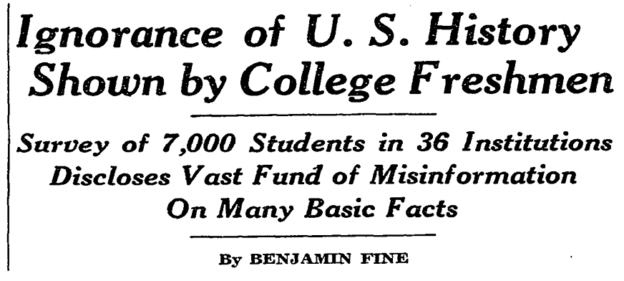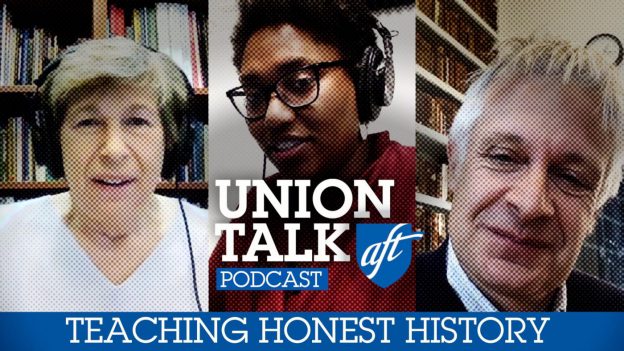Thanks to a Twitter thread by historian Meredith Henne Baker, I read an article from The New York Times entitled “Ignorance of U.S. History Shown by College Freshmen.” In that piece, Benjamin Fine reported the results of 7,000 surveys completed at a substantial set of participating institutions, from Boston University to Yeshiva College.
The results look pretty awful. “A large majority” could not answer questions about Lincoln, Jefferson, Jackson, or Lincoln. Twenty-five percent did not know that Lincoln was president during the Civil War. Students’ geographical knowledge was also deemed poor: “Most of our students do not have the faintest notion of what this country looks like.” Asked about the Bill of Rights, many respondents named rights that are not in that document, including FDR’s four freedoms and women’s suffrage.
None of this sounds like news. We have surely heard it all before. See, for example, “Failing Grades on Civics Exam Called a ‘Crisis’” (New York Times, May 4, 2014).
The interesting point about Fine’s article is its date: April 4, 1943. He uses a lot more words than his 2014 successor, and he combines commentary with reporting in a looser or breezier style. Otherwise, these articles almost rhyme.
I might have expected the results to look better in 1943. College freshmen were a more elite subgroup of the young-adult population then, the curriculum was narrower (giving American history potentially a larger share), and the US was fighting a highly patriotic all-out war. But overall, the statistics looked no better in those days, and maybe worse than today.
When arguing for better civics and historical education, we should avoid the language of decline or current crisis. In reality, levels of civic and historical knowledge–as measured by such instruments–appear remarkably flat despite dramatic changes in education and society. These surveys and their specific questions are subject to debate; people know important things not reported in these articles. Still, it is worth seriously investigating why basic political and historical knowledge seem so persistently poor.
One implication is that quick and easy solutions are unlikely to work. Requirements for courses and tests have come and gone over the past 80 years, with sometimes statistically significant results but no fundamental change.
Another implication is that political reforms must accompany changes in education. Just to name one example, Gimpel, Lay & Schuknecht (2003) found that young people learned and knew more about politics if they grew up in competitive electoral districts rather than “safe” seats. Thus gerrymandering reform would help civic education. That is just an example of how civic knowledge has a demand side as well as a supply side. The more adults are invited to play consequential political roles, the more youth will seek and receive civic education. However, to empower citizens is usually a struggle, because it usually comes at the expense of current power-holders.
A third implication is that we would need bolder policy reforms to improve civic education substantially. Adding or removing a test may matter, but it is a pretty modest intervention. If knowledge of the political system and its history are truly important, we will need more than a course or test.
We have never really tried a sustained and coherent effort to set targets, enact requirements, educate educators, produce materials, assess students, evaluate programs, and improve all the inputs. Educating for American Democracy offers a roadmap for such an effort, and it would be unprecedented.

